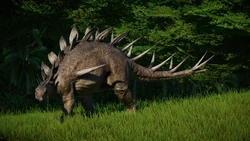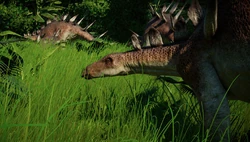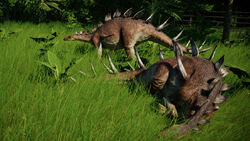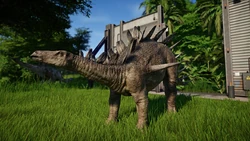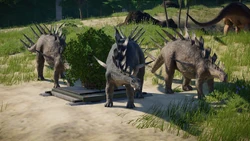| The Kentrosaurus is another of those spikey-backed dinosaurs. A dinosaur that relied on intimidation to keep predators at bay. And failing that, a difficult meal to catch and chew. Think of it as a prehistoric porcupine. |
Kentrosaurus is a genus of stegosaurid dinosaur that originated from Late Jurassic Africa. A small species of stegosaur, Kentrosaurus is unlocked by the Hammond Foundation upon completion of the Entertainment Division mission on Isla Pena.
History
A male Kentrosaurus named Pierce was cloned by Mantah Corp, a bioengineering company that rivals InGen, and lived on a secluded island.[1]
Characteristics
One of the smallest stegosaurid dinosaurs in the Evolution series, reaching up to four meters in length and weighing 700kg, Kentrosaurus has a long narrow skull and a pair of spikes on its shoulders. Its name means "Prickle Lizard". Like many other stegosaurian dinosaurs, Kentrosaurus is well protected from predators, with uniformed rows of narrow armor dorsal plates (more spike-like than its famous cousin) that run the length of its back to its pelvis and a pair of spikes that jut out from its shoulders. It also has a long, spiked tail that helps it to fend off attackers. The base genome of Kentrosaurus is a dark brown color with a creamy underbelly and striped spikes and plates.
Behaviour
In comparison to its larger relative Stegosaurus, the needs of Kentrosaurus are fairly manageable. They require at least three other individuals of their species to fulfil their social needs, and prefer living in an enclosure containing between three and seventeen other dinosaurs of various species. Like other stegosaurids, Kentrosaurus is capable of defending itself against medium and large carnivores, attacking with its dangerous tail during fights. They can be safely housed with small carnivores such as Velociraptor and Proceratosaurus.
Kentrosaurus require at least 4,903 m² of grassland, and 3,332m² of forest, and feed from either Ground Herbivore Feeders, or the Ground Paleofeeder with the addition of the Claire's Sanctuary expansion pack. With the palaeobotany mechanic added with Claire's Sanctuary, Kentrosaurus show a primary preference for Paw Paw, with secondary preferences for Mosses and Cycads. Conversely, however, they are harmed if they consume Rotten Wood, Horsetails or Palms.
Paleontology
Kentrosaurus was first discovered between 1909 to 1911 by a German expedition led by paleontologist Werner Janensch unearthed a series of fossils in the Tendaguru Formation, to Tanzania, then called German East Africa. However, only partial skeletons have been recovered for Kentrosaurus and only in the Tendaguru Formation. It was officially named by Edwin Hennig in 1915, translating to "Sharp Point Lizard" in reference to the spikes on its body. Around 70 fragmented skeletons were found together, showing these dinosaurs moved in herds. After Stegosaurus, Kentrosaurus is the second most well-known stegosaur in popular culture and is more closely related to the latter, than it is to Asian and European stegosaurs such as Chungkingosaurus, Dacentrurus, and Lexovisaurus, although it shares a similar appearance with plates in straight pairs on the back and with an extra pair of spikes on its shoulders.
Paleoecology
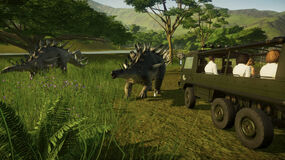
A Jurassic Tour vehicle passes some Kentrosaurus.
Kentrosaurus lived during the Late Jurassic period, around 150-155 million years ago, with in the Tendaguru Formation with its ecosystem primarily consisting of three types of environment: shallow, lagoon-like marine environments, tidal flats and low coastal environments, and vegetated inland environments filled with lush vegetation for the dinosaur to feed on. As well as dinosaur fossils, this site is rich with pterosaurs, early mammals, fish, crocodiles and invertebrates.
The Tendaguru formation in Tanzania is very similar to the Morrison Formation in North America, with inhabiting sauropods such as Dicraeosaurus and possibly Giraffatitan and the ornithopod Dysalotosaurus. A variety of therapods also lived here, including the earliest known carcharodontosaur and spinosaur: Veterupristisaurus and Ostafrikasaurus, respectively.
Available genomes
| Fossil icon | Dig site | Quality | Number available |
|---|---|---|---|
| Tendaguru Formation | ★ ★★ ★★★ ★★★★ |
2 6 12 8 |
Skins
Trivia
- Kentrosaurus was the fifteenth dinosaur to receive a Species Profile, on 27 April 2018.[2]
- Kentrosaurus appeared in Jurassic Park: Operation Genesis, considered by many to be Jurassic World Evolution's spiritual predecessor.
- The Wetland skin of the Kentrosaurus resembles its appearance in Jurassic Park: Operation Genesis.
- Previous database image of Kentrosaurus showed an unused pattern and skin texture similar to that of the Steppe pattern.[3] This was changed with Update 1.10.
Gallery
References
- ↑ Lueras, L., Kreamer, S., Spielberg, S., Trevorrow, C., Marshall, F. (Executive Producers). (2020–2022). Jurassic World Camp Cretaceous [TV series]. Universal Pictures; DreamWorks Animation Television.
- ↑ Frontier Developments. (April 27, 2018). Species Profile - Kentrosaurus [Video]. YouTube. Retrieved October 26, 2019.
- ↑ Previous InGen Database Image
External links
- Kentrosaurus on Wikipedia









